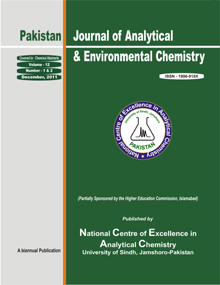Evaluation of Complexation Behavior of Calix[4]arene Derivative
DOI:
https://doi.org/10.21743/Keywords:
Calixarene; Transition metals; Complexation; Liquid-Liquid Extraction; Jobs plotAbstract
In this article we have explored the solvatochromic behavior including solvent selection, time study and complexation ability of 5,11,17,23-Tetrakis(N-piperidinomethyl)-25,26,27,28-tetrahydroxycalix[4]arene (3). The complexation behavior of 3 toward the selected transition metals has been explored through FT-IR, UV-visible and fluorescence spectroscopic techniques. It has been found that the ligand 3 has remarkable complexation ability for all selected transition metal (Cd2+, Cu2+, Ni2+, Co2+, Pb2+, Hg2+) ions used in the experiment with exceptionally high affinity for Hg2+ ions. Besides this, by applying method of continuous variation, i.e. Job's method; the stoichiometric ratio for the complexation between 3 and Hg2+ ion in acetonitrile has been determined, which indicates that 3 forms a 1:1 metal:ligand complex. The strong complexation behavior of 3 for Hg2+ ions was also confirmed by FT-IR and fluorescence spectroscopy. Consequently, it has been deduced that 3 is a versatile compound and can be used in diverse fields such as analytical/environmental chemistry and sensor technology.
Downloads
Downloads
Published
Issue
Section
License
Copyright (c) 2025 Pakistan Journal of Analytical & Environmental Chemistry

This work is licensed under a Creative Commons Attribution-NonCommercial-ShareAlike 4.0 International License.






